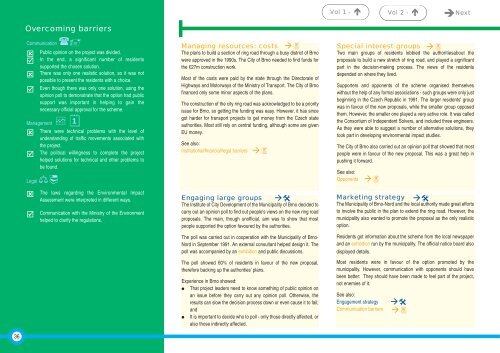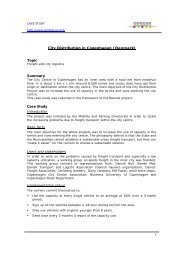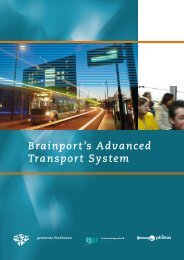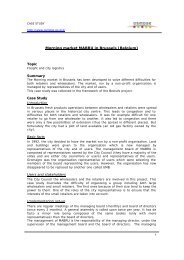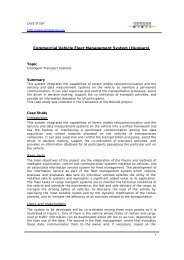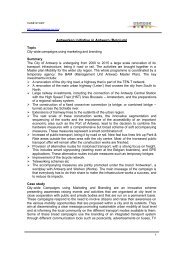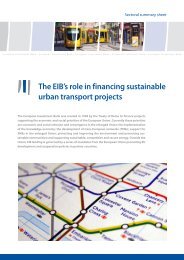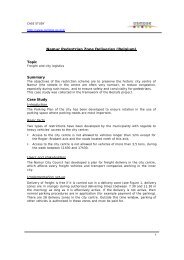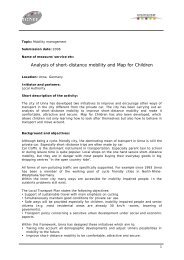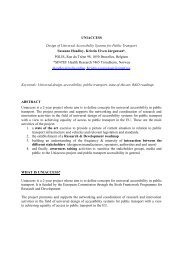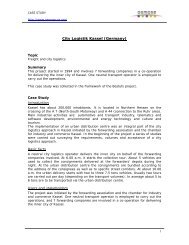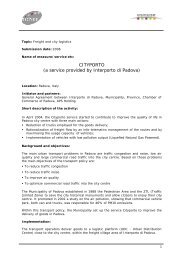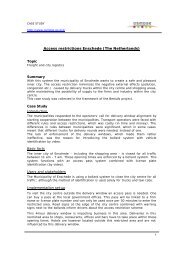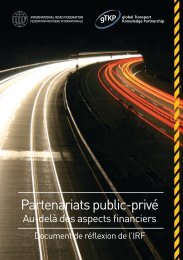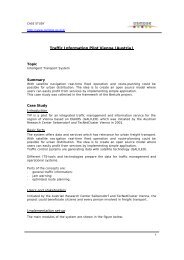Successful transport decision-making - Osmose
Successful transport decision-making - Osmose
Successful transport decision-making - Osmose
You also want an ePaper? Increase the reach of your titles
YUMPU automatically turns print PDFs into web optimized ePapers that Google loves.
Overcoming barriers<br />
Communication <br />
<br />
<br />
Public opinion on the project was divided.<br />
In the end, a significant number of residents<br />
supported the chosen solution.<br />
<br />
There was only one realistic solution, so it was not<br />
possible to present the residents with a choice.<br />
<br />
Even though there was only one solution, using the<br />
opinion poll to demonstrate that the option had public<br />
support was important in helping to gain the<br />
necessary official approval for the scheme.<br />
Management <br />
<br />
There were technical problems with the level of<br />
understanding of traffic movements associated with<br />
the project.<br />
<br />
The political willingness to complete the project<br />
helped solutions for technical and other problems to<br />
be found.<br />
Legal <br />
<br />
<br />
The laws regarding the Environmental Impact<br />
Assessment were interpreted in different ways.<br />
Communication with the Ministry of the Environment<br />
helped to clarify the regulations.<br />
Managing resources: costs<br />
The plans to build a section of ring road through a busy district of Brno<br />
were approved in the 1990s. The City of Brno needed to find funds for<br />
the €27m construction work.<br />
Most of the costs were paid by the state through the Directorate of<br />
Highways and Motorways of the Ministry of Transport. The City of Brno<br />
financed only some minor aspects of the plans.<br />
The construction of the city ring road was acknowledged to be a priority<br />
issue for Brno, so getting the funding was easy. However, it has since<br />
got harder for <strong>transport</strong> projects to get money from the Czech state<br />
authorities. Most still rely on central funding, although some are given<br />
EU money.<br />
See also:<br />
Institutional/financial/legal barriers<br />
<br />
<br />
<br />
Engaging large groups<br />
The Institute of City Development of the Municipality of Brno decided to<br />
carry out an opinion poll to find out people's views on the new ring road<br />
proposals. The main, though unofficial, aim was to show that most<br />
people supported the option favoured by the authorities.<br />
The poll was carried out in cooperation with the Municipality of Brno-<br />
Nord in September 1991. An external consultant helped design it. The<br />
poll was accompanied by an exhibition and public discussions.<br />
The poll showed 60% of residents in favour of the new proposal,<br />
therefore backing up the authorities' plans.<br />
Experience in Brno showed:<br />
That project leaders need to know something of public opinion on<br />
an issue before they carry out any opinion poll. Otherwise, the<br />
results can slow the <strong>decision</strong> process down or even cause it to fail;<br />
and<br />
It is important to decide who to poll - only those directly affected, or<br />
also those indirectly affected.<br />
Vol 1 - <br />
Special interest groups<br />
Two main groups of residents lobbied the authoritiesabout the<br />
proposals to build a new stretch of ring road, and played a significant<br />
part in the <strong>decision</strong>-<strong>making</strong> process. The views of the residents<br />
depended on where they lived.<br />
Supporters and opponents of the scheme organised themselves<br />
without the help of any formal associations - such groups were only just<br />
beginning in the Czech Republic in 1991. The larger residents' group<br />
was in favour of the new proposals, while the smaller group opposed<br />
them. However, the smaller one played a very active role. It was called<br />
the Consortium of Independent Solvers, and included three engineers.<br />
As they were able to suggest a number of alternative solutions, they<br />
took part in developing environmental impact studies.<br />
The City of Brno also carried out an opinion poll that showed that most<br />
people were in favour of the new proposal. This was a great help in<br />
pushing it forward.<br />
See also:<br />
Opponents<br />
<br />
Marketing strategy<br />
The Municipality of Brno-Nord and the local authority made great efforts<br />
to involve the public in the plan to extend the ring road. However, the<br />
municipality also wanted to promote the proposal as the only realistic<br />
option.<br />
Residents got information about the scheme from the local newspaper<br />
and an exhibition run by the municipality. The official notice board also<br />
displayed details.<br />
Most residents were in favour of the option promoted by the<br />
municipality. However, communication with opponents should have<br />
been better: They should have been made to feel part of the project,<br />
not enemies of it.<br />
See also:<br />
Engagement strategy<br />
Communication barriers<br />
Vol 2 - <br />
<br />
<br />
<br />
<br />
Next<br />
36


